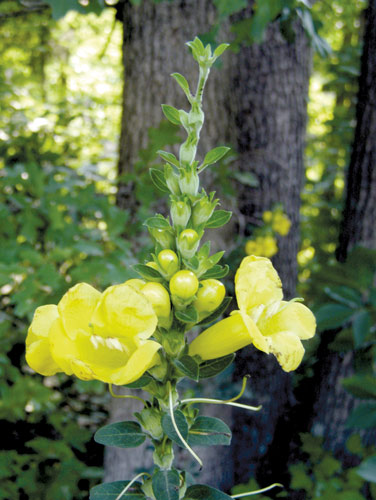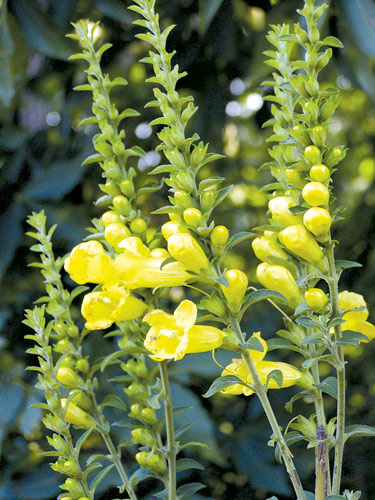False-foxglove?
Originally published July 19, 2008

False-foxglove, Aureolaria, is found beneath the canopy of oak trees. Photo by Ken Moore
By Ken Moore
Now, how can a flower be false? A flower either is or it isn’t! It seems irreverent to call any plant “false.â€
But I’m getting ahead of myself. I was all set to focus on yellow roadside composites (flowers in the aster and sunflower family) for this week’s Flora when I was redirected by a chance spotting of a different yellow wildflower on MLK Boulevard.
They are just now coming into peak flowering. Driving north you will find them on the right woods-edge just beyond Blossom Lane. There is a little satellite dish just inside the woods-edge behind a sizeable population of Aureolaria virginica, false-foxglove. The common name, false-foxglove, refers to the similarity to the cultivated pink foxgloves of western Europe.
A more recently used common name is oak-leach, a reference to the plant’s association as a parasite on the roots of oak trees. Unlike most parasitic plants that lack significant foliage and depend on the host plant for sustenance, the Aureolaria sports numerous oppositely paired leaves on three-to-six-foot-high stems. Thus endowed, Aureolarias must be only semi-parasitic, causing little if any harm to the host plant. Be assured, however, that, as with all things in nature, there is a significant, necessary association going on between these two plants.
Don’t even think about trying to dig a plant for your own garden. And you are not going to find it in a garden center.
Unless you are fortunate enough to find some plants growing naturally beneath some of your oak trees, the best way to procure one of these is to collect seed and sow directly beneath your oak trees. Regrettably, my landscape contains no oaks, so I’ll have to be satisfied with enjoying these handsome perennials in the wild.
Aureolaria virginica is the most common of several species and though it occurs in dry oak woods throughout the state, one doesn’t run into it very often, perhaps because we are seldom walking around these woods during high summer. I haven’t seen Aureolarias in flower for several years; just haven’t been in the right places at the right time! The population up near Timberlyne is one of the largest I’ve ever seen, and those vivid yellow, waxy-textured, one-to-two-inch-long flowers light up that shady oak roadside.
They flower more vigorously where they receive significant sunlight beneath the canopy of the host oaks. So look for them in forest openings and edges exposed to sunlight for part of the day.
Several Aureolaria species are host plants for the larvae of the Baltimore butterfly, a member of the checkered butterfly group. My hunch is that our local Aureolaria is also a host plant. If you’re fortunate enough to have some under your oaks, or discover them on your walks, linger a bit. A sighting of the Baltimore will be worth the wait.
There is definitely nothing false about this plant. Rather than call it by either of the common names, I suggest you call it Aureolaria. Say it out loud. It rolls off your tongue so easily and your friends and neighbors will be mightily impressed!

The roadside population of Aureolaria up near Timberlyne is particularly showy. Photo by Ken Moore


Comments are closed.